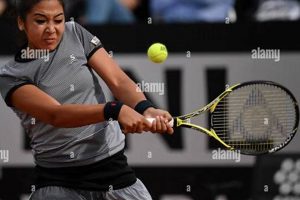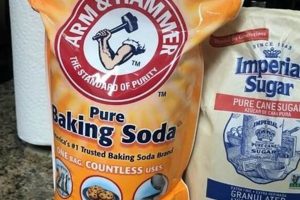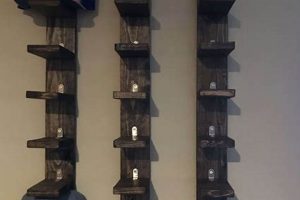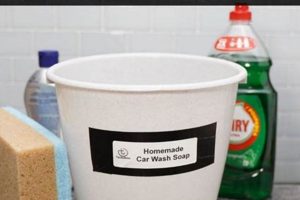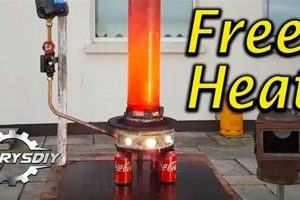A self-constructed covering for a fish tank serves to enclose the aquatic environment. Such a construction typically involves materials like acrylic sheets, polycarbonate panels, or glass, often framed with wood or plastic edging. An example includes a custom-built frame fitted with a clear polycarbonate sheet, designed to rest securely on the aquarium’s upper rim.
Enclosing a fish tank offers multiple advantages. It reduces water evaporation, maintaining stable water parameters and minimizing the need for frequent top-offs. It also prevents fish from jumping out, safeguarding the inhabitants. Furthermore, it can support lighting fixtures, enhancing the visual appeal of the aquarium and promoting plant growth. Historically, simple glass panes were utilized, evolving to more sophisticated designs incorporating ventilation and integrated lighting systems.
The subsequent sections will detail various construction techniques, material selection considerations, lighting integration strategies, and important safety precautions pertinent to this type of project. Specific attention will be given to selecting appropriate materials and ensuring proper ventilation to maintain a healthy aquatic environment.
Construction Considerations
This section outlines crucial factors for successful fabrication, ensuring a functional and safe enclosure for the aquatic environment.
Tip 1: Accurate Measurement is Paramount. Precise dimensions of the aquarium are essential before commencing construction. A slight miscalculation can result in an ill-fitting structure, compromising its intended function. Measure the internal lip of the aquarium for the most accurate fit.
Tip 2: Material Selection Based on Humidity Resistance. Opt for materials resistant to high humidity. Untreated wood can warp and degrade rapidly. Sealants and finishes designed for marine environments offer superior protection. Acrylic and polycarbonate are suitable plastic alternatives.
Tip 3: Incorporate Adequate Ventilation. Sufficient airflow is critical to prevent excessive humidity buildup and maintain healthy gas exchange within the aquarium. Strategically placed ventilation holes or mesh panels are recommended.
Tip 4: Prioritize Safety. When working with cutting tools or adhesives, always adhere to manufacturer safety guidelines. Wear appropriate protective equipment, such as safety glasses and gloves.
Tip 5: Ensure Proper Lighting Integration. If incorporating lighting, allow sufficient clearance between the light fixture and the water surface to prevent overheating and potential damage to the lighting system. Consider the specific lighting needs of the aquarium inhabitants when selecting fixtures.
Tip 6: Secure and Stable Mounting. Ensure a secure and stable mount for the covering to prevent accidental displacement, which could harm the aquarium inhabitants. Use appropriately sized hinges and latches where necessary.
Tip 7: Consider Access Points. Design access points for feeding, maintenance, and equipment adjustments. Hinged sections or removable panels provide convenient access without removing the entire structure.
Adhering to these tips significantly increases the likelihood of a successful project, resulting in a functional, safe, and aesthetically pleasing addition to the aquarium setup.
The subsequent sections will cover advanced topics such as automated control systems and aesthetic enhancements.
1. Accurate Measurements
In the context of a self-assembled aquarium enclosure, precise dimensional assessments are not merely a preliminary step; they are fundamental determinants of the project’s success and the long-term health of the enclosed ecosystem. Accurate measurements directly influence the structural integrity, functionality, and safety of the completed covering.
- Seal Effectiveness
Inaccurate dimensions lead to gaps between the covering and the aquarium rim. These gaps facilitate water evaporation, disrupting the stability of water parameters (pH, salinity, temperature). In saltwater aquariums, even slight evaporation can significantly alter salinity levels, stressing sensitive marine organisms. A properly sealed enclosure, achieved through precise measurements, mitigates this issue.
- Structural Stability
An enclosure with dimensions that deviate substantially from the aquarium’s actual size may lack structural support. Oversized coverings can shift or slide, creating a risk of accidental submersion or displacement. Undersized coverings may not fit securely, posing a risk of collapse and potential harm to the aquarium inhabitants. Precise measurements ensure the covering rests stably and evenly on the aquarium frame.
- Lighting Integration Feasibility
Accurate measurement informs the design and placement of lighting fixtures. Insufficient space can lead to overheating, while excessive space may result in light spillage and reduced efficiency. Proper measurements allow for optimal positioning of lighting, promoting healthy plant growth (in planted aquariums) and showcasing the aquarium’s aesthetics.
- Prevention of Escape
Certain fish species are prone to jumping out of the aquarium. Gaps resulting from inaccurate dimensions create escape routes, leading to the potential death of the fish. Tight-fitting structures prevent this outcome. Ensuring an enclosure is secure and complete reduces stress and maintains biodiversity within the aquarium.
The integration of accurate measurements into the fabrication process ensures the custom-built aquarium enclosure meets the specified needs. The resulting structure becomes not just a covering, but a crucial component in maintaining a stable and thriving aquatic environment. The absence of dimensional accuracy can result in an unstable structure and a compromised ecosystem.
2. Material Selection
The selection of materials in constructing a self-made aquarium enclosure directly influences its performance, longevity, and the health of the aquatic ecosystem it contains. This critical decision requires careful consideration of several factors to ensure the structure effectively serves its intended purpose.
- Moisture Resistance
The constant presence of water and high humidity necessitates materials resistant to degradation and warping. Untreated wood, for example, is unsuitable due to its susceptibility to rot and fungal growth. Acrylic and polycarbonate offer superior moisture resistance, preventing structural damage and maintaining the enclosure’s integrity. The selection of moisture-resistant materials minimizes the need for frequent repairs or replacements.
- Transparency and Light Transmission
If the covering is intended to allow light to penetrate for plan
t growth or viewing purposes, the material’s transparency becomes paramount. Standard glass, acrylic, and specific grades of polycarbonate exhibit high light transmission rates, facilitating photosynthesis and enabling clear observation of the aquarium’s contents. The selection of an opaque material would negate these benefits, requiring alternative lighting solutions. - Chemical Inertness
Materials in direct or indirect contact with the aquarium water must be chemically inert to prevent leaching of harmful substances. Certain plastics and improperly sealed wood can release chemicals that negatively impact water quality and harm aquatic life. Selecting aquarium-safe materials ensures a stable and non-toxic environment for the inhabitants.
- Structural Integrity and Durability
The chosen material must possess sufficient strength and rigidity to support its own weight and any additional load, such as lighting fixtures. Thin or brittle materials can crack or warp under stress, compromising the enclosure’s integrity. The structural integrity of the material contributes to the overall safety and stability of the covering, preventing potential accidents or damage.
These considerations underscore the importance of informed material choices in aquarium enclosure construction. Selection requires balancing transparency, durability, moisture resistance and chemical properties, thereby directly influencing the effectiveness and the longevity of the structure.
3. Adequate Ventilation
Effective ventilation within a self-constructed aquarium enclosure is not merely a design consideration but a necessity for maintaining a stable and healthy aquatic ecosystem. It directly influences water quality, prevents the buildup of harmful gases, and mitigates excessive humidity, all of which are critical for the well-being of the aquarium inhabitants.
- Gas Exchange Optimization
Aquatic organisms consume oxygen and release carbon dioxide as a byproduct of respiration. Insufficient air circulation hinders the exchange of these gases, leading to a buildup of carbon dioxide and a depletion of oxygen. This imbalance can stress the inhabitants. Properly designed ventilation promotes the diffusion of carbon dioxide out of the aquarium and the replenishment of oxygen from the surrounding air. This facilitates optimal respiration for fish, invertebrates, and beneficial bacteria within the system.
- Humidity Control
Water evaporation from the aquarium surface increases humidity levels within the enclosed space. Excess humidity can condense on the underside of the covering, potentially leading to mold growth and accelerated corrosion of lighting fixtures. Adequate ventilation allows for the escape of moisture, preventing condensation and maintaining a drier environment. This safeguards the structural integrity of the covering and protects sensitive equipment.
- Temperature Regulation
Enclosed aquariums can trap heat, leading to elevated water temperatures, particularly during warmer months or when high-intensity lighting is used. Excessive heat stress can compromise the health of many aquatic species. Ventilation assists in dissipating heat, maintaining a more stable and optimal temperature range within the aquarium. The cooling effect of moving air can prevent overheating and reduce the need for additional cooling devices.
- Prevention of Anaerobic Conditions
Stagnant air pockets within the enclosure can foster the development of anaerobic conditions, promoting the growth of harmful bacteria that produce toxic byproducts, such as hydrogen sulfide. These gases can be lethal to aquarium inhabitants. Ventilation minimizes the formation of these anaerobic zones, preventing the accumulation of noxious compounds and maintaining a healthier environment.
Integrating adequate ventilation into the fabrication of a self-constructed enclosure addresses critical environmental needs within the aquarium. It directly supports the biological processes of the aquatic organisms and preserves the physical integrity of the system. Ventilation is a critical requirement, preventing the detrimental effects of gas imbalance, excessive moisture, and thermal buildup within the enclosed aquatic environment.
4. Lighting Integration
In the context of a self-constructed aquarium covering, “Lighting Integration” refers to the incorporation of illumination systems within or supported by the structure. This aspect is critical for promoting photosynthesis in planted aquariums, enhancing the visual appeal of the aquatic environment, and supporting the overall health of the ecosystem. The integration of lighting systems presents both opportunities and challenges, necessitating careful planning and execution.
- Spectrum and Intensity Optimization
Different aquatic organisms have specific light requirements. Plants, for example, require specific wavelengths of light for photosynthesis. The selection of lighting fixtures with appropriate spectral output and intensity is essential for promoting healthy plant growth and vibrant coloration in fish and corals. Inadequate or excessive light can lead to algae blooms or inhibited plant growth. Careful consideration of the specific needs of the aquarium inhabitants guides the selection of appropriate lighting technology.
- Heat Dissipation Management
Lighting fixtures generate heat, which can significantly impact water temperature within an enclosed aquarium. Proper heat dissipation mechanisms, such as ventilation or heat sinks, are crucial for preventing overheating and maintaining a stable thermal environment. Failure to address heat management can lead to stress or mortality of aquatic organisms. The design of the enclosure must incorporate sufficient ventilation or cooling systems to mitigate the effects of heat generated by the lighting.
- Fixture Mounting and Stability
The method of mounting the lighting fixtures to the covering must ensure stability and prevent accidental submersion or dislodgement. Secure mounting mechanisms, such as brackets or suspension systems, are essential for safety and functionality. Unstable fixtures can pose a hazard to the aquarium inhabitants and disrupt the lighting regime. The design of the covering must accommodate the weight and dimensions of the lighting fixtures, ensuring a secure and stable installation.
- Electrical Safety Considerations
Working with electrical components near water presents inherent safety risks. All electrical connections must be properly insulated and grounded to prevent electrical shock. The use of ground fault circuit interrupters (GFCIs) is highly recommended. Wiring should be routed and secured to prevent contact with water or condensation. Adherence to electrical safety codes and best practices is paramount to ensure the safety of both the aquarium inhabitants and the individual maintaining the system.
The integration of lighting into a self-constructed aquarium enclosure demands a comprehensive approach. It is imperative to address the specific lighting needs of the aquarium inhabitants, manage heat dissipation, ensure secure fixture mounting, and prioritize electrical safety. These interconnected elements directly influence the success and
stability of the aquatic environment, highlighting the importance of thoughtful planning and execution during the construction process.
5. Structural Integrity
Structural integrity, in the context of a self-assembled aquarium enclosure, defines the capacity of the structure to withstand anticipated stresses without deformation or failure. Its role is paramount, as a compromised structure can lead to catastrophic water loss, potential harm to aquatic inhabitants, and damage to surrounding property. Examples of structural failures range from simple warping of the enclosure due to inadequate material thickness to complete collapse under the weight of integrated lighting or accumulated condensation. Therefore, the consideration of static and dynamic loads is fundamental to ensuring a stable and safe environment. Material selection, joint design, and overall geometry directly contribute to this attribute.
The practical application of structural integrity principles necessitates the use of appropriate materials with sufficient strength and rigidity. For example, an acrylic sheet used as a covering must possess adequate thickness to resist bending under its own weight, preventing light distortion and maintaining a secure seal. Similarly, wooden frames must be constructed with joints capable of withstanding the constant humidity, preventing warping and eventual failure. Furthermore, the addition of cross-bracing or reinforcement can significantly enhance structural stability, particularly for larger aquariums or enclosures incorporating heavy lighting systems. Incorrect implementation can have far-reaching effects on the aquarium’s ecosystem.
In summary, structural integrity is a non-negotiable component of a self-made aquarium enclosure. Ensuring this attribute demands a thorough understanding of material properties, load calculations, and appropriate construction techniques. While the aesthetic design of the enclosure is important, prioritizing structural stability minimizes the risk of failure, safeguarding the aquatic environment and the surrounding area. Future advancements in materials science and fabrication techniques may further enhance the ability to create robust and reliable structures, although fundamental principles of structural engineering will continue to be of prime importance.
6. Aquarium Safety
Aquarium safety, when considered within the context of self-constructed aquarium enclosures, represents a critical domain that encompasses the well-being of the aquatic inhabitants, the safety of individuals interacting with the system, and the minimization of potential hazards. The design and construction of a “diy aquarium lid” directly influences various aspects of aquarium safety. For example, the use of non-aquarium-safe materials can leach harmful chemicals into the water, poisoning the aquatic ecosystem. Similarly, inadequate ventilation can lead to the build-up of toxic gases, creating an unsafe environment. Furthermore, a poorly constructed lid can be unstable, posing a risk of collapse and physical harm to the fish or invertebrates within the tank. Therefore, aquarium safety must be a central consideration throughout the design and construction process.
Practical applications of safety principles manifest in several ways. The selection of inert materials, such as aquarium-grade silicone and non-toxic plastics, is essential for preventing chemical contamination. Proper ventilation strategies, including strategically placed vents or the use of mesh panels, are critical for maintaining adequate gas exchange. Secure lid construction, incorporating features such as reinforced frames and reliable latches, minimizes the risk of accidental dislodgement or collapse. Moreover, the integration of electrical components, such as lighting systems, demands strict adherence to safety codes, including the use of ground fault circuit interrupters (GFCIs) and proper insulation to prevent electrical hazards. An example of neglecting such safety measures might involve using an unmodified household electrical cord, leading to corrosion and potential electrocution risk from water contact. This necessitates using specialized aquarium-safe waterproof electrical components.
In summary, aquarium safety is not an optional add-on but an integral component of any self-constructed aquarium enclosure. Ensuring a safe aquatic environment requires a holistic approach that encompasses material selection, ventilation design, structural integrity, and electrical safety precautions. Addressing these considerations minimizes the risk of harm to the aquarium’s inhabitants and ensures the long-term stability and health of the aquatic ecosystem. Challenges persist in balancing cost-effectiveness with safety, necessitating informed decision-making and a commitment to prioritizing the well-being of the aquarium and its inhabitants.
Frequently Asked Questions
The following questions address common inquiries and concerns regarding the construction and implementation of self-made aquarium coverings. These are intended to clarify essential aspects and promote informed decision-making.
Question 1: What materials are most suitable for constructing an enclosure given variable humidity levels?
Materials exhibiting high resistance to moisture and warping are recommended. Acrylic and polycarbonate represent viable options. Untreated wood is generally unsuitable due to its propensity for decay. Marine-grade sealants and finishes may enhance the durability of wooden components. Consideration of long-term exposure to high humidity is essential for material selection.
Question 2: How can adequate ventilation be achieved within a closed aquarium system?
Strategically positioned ventilation holes or the integration of mesh panels facilitate adequate air circulation. The size and quantity of vents should be proportionate to the aquarium’s volume and the metabolic activity of its inhabitants. Forced-air ventilation systems may be necessary in certain applications to ensure optimal gas exchange. Maintaining a balance between ventilation and evaporation control is paramount.
Question 3: What safety precautions must be observed when integrating electrical components into a self-constructed aquarium structure?
All electrical connections must be properly insulated and grounded. The use of ground fault circuit interrupters (GFCIs) is strongly advised to mitigate the risk of electrical shock. Wiring should be secured to prevent contact with water. Adherence to established electrical safety standards is crucial for protecting both the aquarium inhabitants and individuals maintaining the system.
Question 4: How does the structural integrity of a self-made covering influence aquarium safety?
A structurally unsound enclosure poses a significant risk of collapse, potentially harming the aquarium inhabitants and causing water damage. Materials must be capable of supporting their own weight, as well as any additional load, such as lighting fixtures. Joints must be robust and resistant to degradation from humidity. Regular inspection of the structure is recommended to identify and address any signs of weakening.
Question 5: What are the potential drawbacks of neglecting proper lighting integration?
Improper lighting integration can lead to various problems, including overheating of the water, insufficient light for photosynt
hetic organisms, and potential damage to lighting fixtures. The spectrum and intensity of light must be appropriate for the specific needs of the aquarium’s inhabitants. Inadequate heat dissipation can elevate water temperatures to lethal levels. A balanced approach to lighting is crucial for maintaining a healthy and stable aquarium environment.
Question 6: How does the choice of materials affect the long-term health of the aquarium’s ecosystem?
Certain materials can leach harmful chemicals into the water, disrupting the delicate balance of the aquatic ecosystem. It’s important to choose materials that are chemically inert and deemed safe for aquarium use. Avoid using materials that may contain heavy metals, formaldehyde, or other toxins. Prioritizing the use of aquarium-safe materials is fundamental to ensuring the well-being of the aquatic inhabitants.
These considerations underscore the multifaceted nature of constructing aquarium enclosures, emphasizing the importance of thoughtful planning, informed material selection, and adherence to safety guidelines. The successful implementation of these factors contributes to a thriving aquatic environment.
The subsequent section explores advanced techniques in aquarium enclosure design.
Conclusion
The preceding sections have delineated the complexities associated with self-constructing an aquarium enclosure. Key considerations encompass material selection, ventilation management, lighting integration, structural integrity, and adherence to stringent safety protocols. A thorough understanding of these elements is indispensable for creating a functional and secure environment for aquatic life.
The effectiveness of a “diy aquarium lid” hinges upon meticulous planning and execution. While cost savings may be a motivating factor, compromising on quality or safety is ill-advised. Prospective constructors must carefully weigh the potential benefits against the inherent risks. Continuous evaluation and adaptation of the design are critical for long-term success in maintaining a thriving aquatic ecosystem. Future innovations in materials and design may offer enhanced solutions, but fundamental principles of responsible construction remain paramount.


